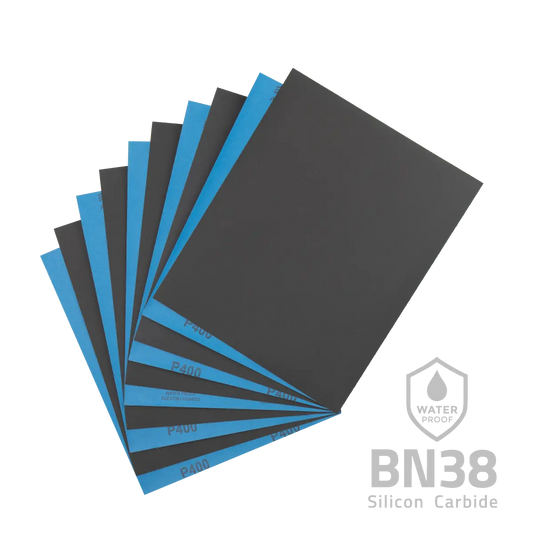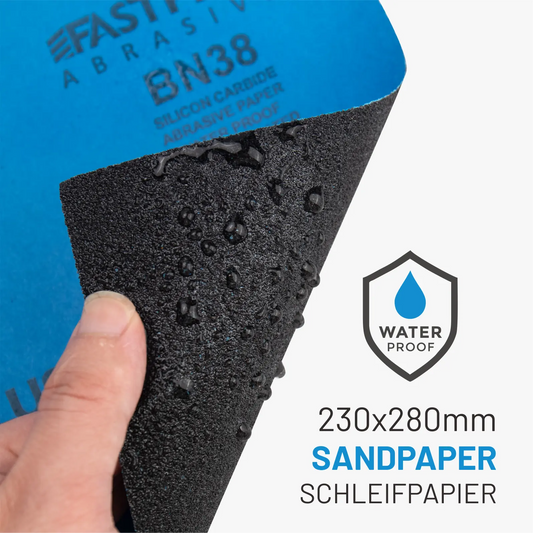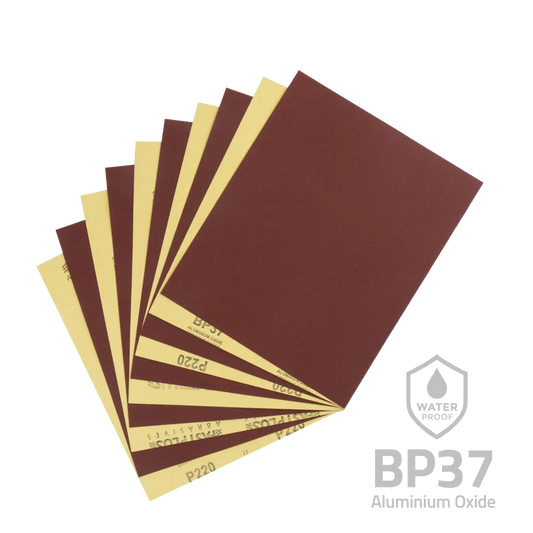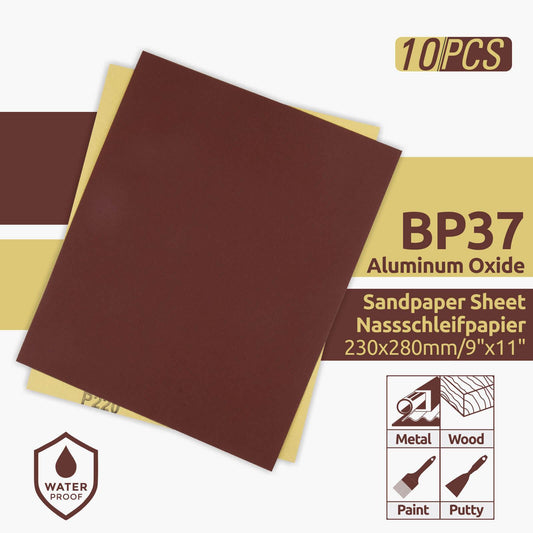
WET DRY SANDPAPER
Size: 230x280mm | Waterproof | Wet Dry Sanding
-
Wet and Dry Sandpaper, BN38 SiC 230x280mm 10 pieces
5.0 / 5.0
(42) 42 total reviews
Regular price From €5,00Regular priceUnit price / per -
Wet or Dry Sandpaper, BP37 230x280mm 10 pieces
5.0 / 5.0
(10) 10 total reviews
Regular price €5,00Regular priceUnit price / per€4,50Sale price €5,00
Collection: Wet Dry Sandpaper 230x280mm
Fastplus Abrasives offers Wet / Dry Silicon Carbide and Aluminium Oxide Sandpaper Sheets from coarse to ultra-fine. The sandpaper sheets are ideal for sanding and finishing plastics, metal, body fillers, lacquers, primers, and clear coats. These waterproof sandpaper sheets are designed to meet all your sanding needs and are tailored to provide an exceptional finish for your projects.
BN38 Waterproof Sandpaper
Our BN38 Waterproof Sandpaper with silicon carbide grit is a standout product in our collection. This waterproof sandpaper is perfect for wet sanding applications, providing a smooth finish even in damp conditions. The silicon carbide grit ensures durability and effectiveness, making it the best sandpaper for those seeking longevity and resilience.
BP37 Wet and Dry Sandpaper
Next, we have the BP37 Wet and Dry Sandpaper with aluminium oxide grit. This sandpaper can be used both wet and dry, offering flexibility for your project needs. The aluminium oxide grit ensures a smooth finish, making it a reliable choice for various tasks.
Silicon Carbide Sandpaper Sheet
Our Silicon Carbide Sandpaper Sheet is a super fine sandpaper that's perfect for detailed work. Its fine grit allows for a polished finish, making it an excellent choice for precision tasks.
Aluminium Oxide Sandpaper Sheet
The Aluminium Oxide Sandpaper Sheet in our collection is known for its toughness and efficiency. It's the best sandpaper for heavy-duty tasks, ensuring a high-quality finish even under strenuous use.
Sandpapers for Wet Sanding
For those who prefer wet sanding, we offer 230x280mm sandpapers for Wet Sanding. These are made with latex paper and designed to be used with water, reducing dust and allowing for a cleaner working environment. They're a testament to our commitment to providing safe and efficient solutions.
230x280mm Sandpaper Sheet
our sandpaper sheet comes with 230x280mm and offers a large surface area for broader applications. Despite its size, it maintains the high-quality finish that our customers have come to expect from our products.
FastPlus Sandpaper
All our sandpaper sheets are recognized as FastPlus Sandpaper and are designed with the user in mind. They're easy to use, durable, and provide a high-quality finish, making them a reliable choice for both professionals and DIY enthusiasts.
Applications of Wet Dry Sandpaper
The wet abrasive sandpapers are ideal for hand-sanding both wet and dry. Available in many grits and cut to fit various hand tools, the many varieties of abrasives and treatments provide user versatility for general-purpose sanding of many materials:
- Body Fillers
- Paint
- Lacquers
- Metal
- Ferrous Metal
- Non-Ferrous Metal
- Stainless Steel
- Composite
- Granite
- Marble
- Glass
- Plastic
- PVC
How to Select the Right Sandpaper Grit?
Sandpaper is graded based on the number of abrasive particles per square inch that make up the sandpaper. The higher the number, the smaller the grains and the finer the sandpaper grit.
And, conversely, lower numbers indicate larger grains and overall coarser sandpaper.
P80 For correcting heavy areas of unevenness.
P120 For roughening before priming or pickling.
P180 For initial sanding after priming.
P240 For initial wet sanding after priming.
P400 For smoothing filled surfaces.
P600 For fine sanding before painting.
P1000 For final fine sanding before painting.
P1200 For final fine sanding before painting.
P2000 For final fine sanding before painting.
Conclusion
In conclusion, our Wet and Dry Sandpaper offers a comprehensive range of products to suit any sanding task. Whether you need waterproof sandpaper for wet sanding or a super fine sandpaper for detailed work, we have you covered. Experience the difference with our high-quality sandpaper today.






